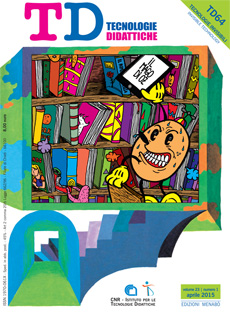Smart Diary: uno strumento per promuovere il benessere socio-emotivo a scuola
Contenuto principale dell'articolo
Abstract
Dettagli dell'articolo
Gli autori che pubblicano su questa rivista accettano le seguenti condizioni:
- Gli autori mantengono i diritti sulla loro opera e cedono alla rivista il diritto di prima pubblicazione dell'opera, contemporaneamente licenziata sotto una Licenza Creative Commons CC BY 4.0 Attribution 4.0 International License.
- Gli autori possono aderire ad altri accordi di licenza non esclusiva per la distribuzione della versione dell'opera pubblicata (es. depositarla in un archivio istituzionale o pubblicarla in una monografia), a patto di indicare che la prima pubblicazione è avvenuta su questa rivista.
- Gli autori possono diffondere la loro opera online (es. in repository istituzionali o nel loro sito web) prima e durante il processo di submission, poiché può portare a scambi produttivi e aumentare le citazioni dell'opera pubblicata (Vedi The effect of Open Access).
Riferimenti bibliografici
Andersson, G. (2009). Using the Internet to provide cognitive behavior therapy. Behavior Research and Therapy, 47(3), 175-180. Bernard, M. E. (1995). Improving student motivation and school achievement: a professional development program for teachers, special educators, school administrators and pupil service personnel. ONT, CA, USA: Hindle and Associates.
Bernard, M. E. (2004). The relationship of young children’s social and emotional development and reading achievement. In Proceedings of the annual conference of the Australian Council for Educational Research, Adelaide, October 2004.
Bernard, M. E., & Pires, D. (2006). Emotional Resilience in Children and Adolescence: Implications for Rational-Emotive Behavior Therapy. In A. Ellis & M. E. Bernard (Eds.), Rational Emotive Behavioral Approaches to Childhood Disorders. New York, NY: Kluwer AcademicPlenum Publishers.
D’Amico, A., & De Caro, T. (2009). CD-ROM Sviluppare l’intelligenza emotiva: percepire, usare, comprendere e gestire le emozioni. Difficoltà di apprendimento, 14(3), 119-127.
Di Pietro, M. (1992). L’Educazione Razionale Emotiva per la prevenzione e il superamento del disagio psicologico dei bambini. Trento, IT: Erickson.
Di Pietro, M. (1999). L’ABC delle mie emozioni. Trento, IT: Erickson.
Elias, M. J. (2006). The connection between academic and social-emotional learning. In M. J. Elias & H. Arnold (Eds.), The Educator’s Guide to Emotional Intelligence and Academic Achievement. Thousand Oaks, CA: Corwin Press. Retrieved from http://www.corwin.com/ upm-data/ 8299_Ch_1.pdf
Ellis, A. (1962). Reason and Emotion in Psychotherapy. Secaucas, NJ: Lyle Stuart.
Ellis, A. (1994). Reason and Emotion in Psychotherapy, Revised and Updated. New York, NY,: Carol Publishing.
Knaus, W. J. (1974). Rational-emotive education: A manual for elementary school teachers. New York, NY: Institute for Rational- Emotive Psychotherapy.
Knaus, W. J. (2001). Rational Emotive Education Past, Present, And Future. Retrieved from http://www.rebtnetwork.org
Matthews, M., Doherty, G., Sharry, J., & Fitzpatrick, C. (2008). Mobile phone mood charting for adolescents. British Journal of Guidance & Counselling, 36(2), 113-129.
Mattila, E., Pärkkä, J., Hermersdorf, M., Kaasinen, J., Vainio, J., Samposalo, K., Merilahti, J., et al. (2008). Mobile diary for wellness management - results on usage and usability in two user studies. IEEE transactions on information technology in biomedicine: a publication of the IEEE Engineering in Medicine and Biology Society, 12(4), 501-12.
Pedron, M., Re, A. M., & Lucangeli, D. (2014). Ansia e matematica: la storia di Emma. Difficoltà in matematica, 10(2), 203-220.
Popa, C., & Bochis, L. (2012). The effects of a rational emotive behaviour education program on the sociometric status and interpersonal perception modification of 9-10 year old Romanian pupils. Procedia - Social and Behavioral Sciences, 46, 5792-5796.
Preziosa, A., Grassi, A., Gaggioli, A., & Riva, G. (2009). Therapeutic applications of the mobile phone. British Journal of Guidance & Counselling, 37(3), 313-325.
Rinn, B. (2011). iCBT. Retrieved from http:// itunes.apple.com/it/app/icbt/id355021834?mt =8
Roberts, R., & Di Pietro, M. (2004). Positivamente. Laboratorio per sviluppare il pensiero razionale-emotivo. Trento, IT: Erickson.
Silverman, S., & Di Giuseppe, R. (2001). Cognitive-behavioral constructs and children’s behavioral and emotional problems. Journal of Rational-Emotive & Cognitive-Behavior Therapy, 19(2), 119-134.
Spencer, S. (2005) Rational Emotive Behavior Therapy: its effectiveness with children. Retrieved from http://citeseerx.ist.psu.edu/ viewdoc/download?doi=10.1.1.390.7308&rep =rep1&type=pdf
Terminello, A., D’Amico, A., Chifari, A. & Merlo, G. (2012). Meta-emotive intelligence, mindfulness and scholastic learning: A treatment study. In M. Cantoia, B. Colombo, A. Gaggioli, & B. Girani De Marco (Eds.), Metacognition 2012. Proceedings of the 5th biennial meeting of the EARLI special interest Group 16 Metacognition (p.163), Milano 5-8 Settembre. Milano, IT: EDUCatt.
Vernon, A. (1989). Thinking, Feeling, Behaving: An Emotional Educational Curriculum for Children. Champaign, IL: Research Press.

